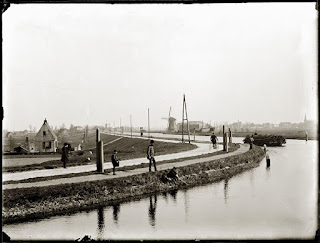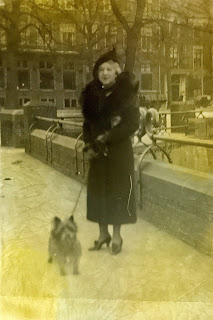Garde d'Honneur - military honor or hostage?
 |
| Members of the new Garde d'Honneur leaving Amsterdam, April 1813. Jan Peelen was in the third group which left in July 1813 for Metz. (Print by Reinier Vinkeles, Public Domain, Rijks Museum Amsterdam) |
However, with a predominantly Dutch family history my male ancestors were affected by the conscription introduced in 1810 when the Kingdom of Holland was part of the French Empire under Napoleon. All men aged 20 years or older had to register. A lottery then determined who would be enlisting in the French army. This system was retained even after French rule ended in 1813 with the defeat of the French army at the battle of Leipzig in October and the reinstatement of the monarchy with the return of Prince William Frederik of Orange-Nassau on 30th November 1813 to the Netherlands. Of course, the "winners" in this lottery now joined the Dutch Army.
It was different though for Jan Peelen, who was born in Amsterdam on 13th November 1794 and joined the Garde d' Honneur in Metz on 15 July 1813. (Ref: Stamboom van de Familie Peelen, alleen de mannelijke lijn) He was 18 years old. An amazing story now unfolds as I investigate further.
The Garde d'Honneur (Guard of Honour) was formed by Napoleon to shore up his declining power in Europe after his disastrous military defeat to Russia in the winter of 1812. More manpower was needed and on 3 April 1813 the Senate in Paris approved the call for more conscripts from the empire. In addition, it approved the formation of the Garde d'Honneurs, made up of 10,000 men in total, selected from the well to do families, the highest tax paying families listed on the cash registers, (Reference: http://www.crommelin.org/history/Ancestors/Garded_honneur/Garded_honneur.htm)
The new regiments were to be quartered in Metz, Tours, Versailles and Lyons. They had to supply their own uniforms and other basics and in modern money terms this meant a cost of 4900 Euro. Not cheap. The uniform was very fancy though, navy with braids and trims in red and white. Topped with a striking headdress and was supplied through a central depot, so that everyone had the same quality and look.
(Reference: http://www.crommelin.org/history/Ancestors/Garded_honneur/Garded_honneur.htm)
Effectively Napoleon was taking hostages from the wealthy to head off any rebellion from these quarters. The Gardes d'Honeur were not placed on the front lines, but kept in reserve. Letters home from Garde members describe a fairly purposeless and boring life, and the writers were anxious for their family to respond.
(Reference: http://www.geschiedenisbeleven.nl/brieven-uit-napoleons-garde-dhonneur/)
There was fierce opposition from Amsterdam and other cities in The Netherlands. The mayor of Amsterdam refused to supply the tax registers, but after two days he gave in.
In the lottery system of conscription one could pay for a replacement - this was now not allowed. Also there were reasons one could be excused from service - ill health, physical disabilities, family reasons, being the only surviving son. None of these counted. The Prefect of the Zuiderzee, who administered Amsterdam, the Belgian Antoine Ph.F.Gh. Visscher Count De Celles was absolutely ruthless and rigid and highly unpopular.
Jan Peelen was in the third intake. It seems that the records are not consistent. He was listed at first as Jean Peelen, son of a merchant of the same name from Weesp, on the "Tableau nominitif des Gardes d'Honneurs" but not on the "Liste alphabetique des Jeunes Gens appels a concourir a la formation des Regiments des Gardes d'Honneur" and then finally he appears on the list "Heeren garde d'honneurs van het depart. Zuiderzee", which is stored at the City Archives of Amsterdam. He was in the third intake of forty two men who departed on 15th July 1813. (Reference: http://schoolreisje-paradijsje.blogspot.com.au/2012/07/belegering-van-naarden-1813-1814.html)
Also included in this third intake was a Gerrit Jacob Gilhuis and this makes me sit up, take note. (Reference: http://www.dbnl.org/arch/_nav001190201_01/pag/_nav001190201_01.pdf)
Jan Peelen married Geertrui Marie Gilhuys on 12 June 1819 in Zuylen, The Netherlands. Could it be that Gerrit Jacob Gilhuis was a relative, perhaps a brother, of Geertrui Maria Gilhuys? True, the spelling is different, but that is, as I now know, not uncommon. Something to investigate a little further. But, suppose this is true, then could they've met this way?
In July 1813 Geertrui would have been almost fourteen years old and if I'm right about Gerrit Jacob being her brother then she might have met her husband to be for the first time around this time. Jan Peelen would have cut a handsome figure in his splendid uniform. Certain to impress a young girl.
I have not found any record so far to indicate when he left the Garde d'Honneur and returned home so I'm assuming it would have been some time after November, after Napoleon was defeated at Leipzig, at the battle of Nations.
In one of the lists Jan's father is said to be a merchant from Weesp. However, on my familytree it is Tabaks Fabrikant - Tobacco Manufacturer - and also that he was a member of the "Gecommitteerde tot de Regering der Stad Weesp", in other words, Jan's father was not just wealthy but also a member of the Executive Committee (like Town Council) of the city of Weesp. This adds a deeper perspective. Weesp was a fortified city, a military town, as well as a manufacturing centre, and this adds weight to the argument that the Garde d'Honneur was effectively a kidnapping of wealthy heirs as insurance for Napoleon maintaining support among the ruling classes in his dominions.
Jan Peelen probably went to work in his father's business for a while and then probably set up his own brickmaking factory; Steenbakker - brickmaker, as it is stated on the family tree (Ref: Stamboom van de Familie Peelen, alleen de mannelijke lijn) in Oostwaarde, Zuylen.
Jan en Geertrui had twelve children, of which nine survived to adulthood, and my great grandfather Jan Peelen was their fourth child. Jan senior passed away 30 March 1859 in Maarssen, The Netherlands, just weeks before his son Jan's wedding to Anna Hendrika Knoops and their departure for Cairo where young Jan Peelen was employed by the Pasha of Egypt to build an iron smelter. Geertrui passed away 26th December 1867.




Comments
Post a Comment